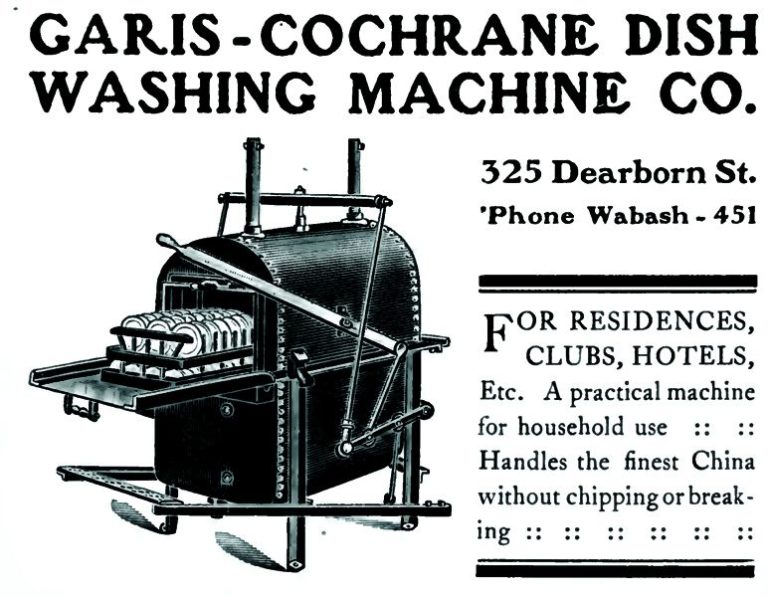Josephine Cochrane invented the first functional dishwasher. We can link this invention to other everyday ones made by women in the late 19th and 20th centuries: the sewing machine (Helen Blanchart), the hypodermic syringe (Letitia Geer), the coffee machine (Melitta Bentz), the disposable nappy (Marion Donovan), the lifeboat (Maria Beasley), the ink pen (Bette Nesmith Graham) or the windscreen wiper (Mary Anderson).

Josephine Cochrane
Ohio, 08-03-1839 — Illinois, 03-08-1913
Període d'activitat: 1886 — 1913
Classificació geogràfica: Amèrica > Estats Units
Moviments socio-culturals
Edat contemporània
Grups per àmbit de dedicació
Tecnòlogues > Inventores
Professionals / Altres grups > Empresàries / Directives / Administradores
Context de creació femenina
Ressenya
She invented the first functional dishwasher and obtained numerous patents related to it. She founded a company to manufacture it commercially, the origin of today's Whirlpool.
Activitats
Justificacions
Biografia
Born in Ashtabula County, Ohio, she was the daughter of Irene Fitch Garis and John Garis, a civil engineer who developed a swamp drainage pump and was involved in the founding of Chicago. Her grandfather, John Fitch (1743-1798), was the inventor of the "Perseverance" (1787), the first operational steamship in the USA.
Josephine married William Apperson Cochran (1831-1883), a prosperous textile merchant and influential local politician who died prematurely at the age of 45, leaving numerous debts to the family. Josephine adds a final e to her married name to become Cochrane.
After the death of her husband, Josephine began to develop the idea for her new dishwasher in the stable at home and with the help of a railway mechanic friend, and in 1886 she obtained the first patent for her invention (no. 355139). She then founded a company to market the invention and in 1887 sold the first machine to the Palmer House Hotel in Chicago. Initially, it was a machine designed for industrial use in hotels, canteens, etc.
In 1893, she presented different models at the Universal Exhibition in Chicago, winning a diploma and a medal as prizes for the best mechanical construction for its durability, suitability, productivity, and quality, competing victoriously against non-automatic dishwashers from national and foreign inventors.
In 1886, Josephine Cochrane was granted a first patent (no. 355139) for her invention. She then established the Garis-Cochrane Dish Washing Machine Company in Shelbyville, with the aim of marketing the machine through visits to potential customers by the inventor herself (she was active in this until 1912) or through advertising, also written by Cochrane and inserted in newspapers, to hotels, restaurants, canteens, hospitals and schools.
In 1897, she set up Cochran's Crescent Washing Machine Company, with the aim of manufacturing the machines and introducing them into domestic kitchens, obtaining a total of 5 patents in the period 1897-1909. She patented a small model specifically adapted to households, which began to be marketed in 1911.
Josephine Cochrane died in Chicago at the age of 74 and her companies were subsequently acquired by The Hobart Manufacturing Company.
Although Josephine marketed a small dishwasher for domestic use, it was not very successful due to its cost and need for complicated water and electricity installations, and it was not until 1950 that it began to be widely used as a household appliance.
 24/03/2022
24/03/2022
Obres
Different dishwasher patents.
Bibliografia
Mujeres con ciencia, 24/03/2022, https://www.mujeresenlahistoria.com/2014/09/la-inventora-del-lavavajillas-josephine.html
https://mujeresconciencia.com/2017/04/28/josephine-garis-cochrane-1839-1913/
Wikipedia, 24/03/2022, https://es.wikipedia.org/wiki/Josephine_Cochrane
Enfocament Didàctic
You can work with this author in Technology and Society at different levels, as well as in the other subjects in 4th of ESO.